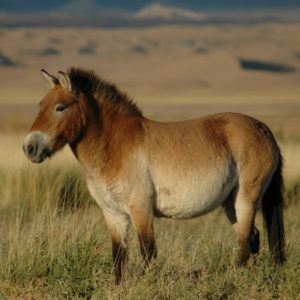When the earliest known horses evolved starting around 55 million years ago, multiple species existed at the same time. Even 10 million years ago, there were still up to a dozen different species. Today, however, the horse family (Equidae), is relatively small, and only seven species – including donkeys and zebras – are in existence.1
Because of its origins as an animal with odd-numbered toes on its rear and front legs, the horse shares a common ancestry with the rhinoceros.
Przewalski’s Horse

A separate species, the Przewalski’s Horse, is the only surviving subspecies of horse that has never been domesticated. With 66 chromosomes instead of the 64 found in other horse species, the Przewalksi’s Horse is genetically distinct.
Although this species – native to Central Asia – became extinct in the Mongolian wild during the 1960s, efforts to reintroduce the Przewalski’s Horse has been met with some success, thanks to an intensive breeding program with captive animals during the 1990s. As of 2005, an estimated 300 Przewalksi’s Horses were running free in Mongolia’s wild.2
Evolutionary Stages of the Horse
It’s important to note there were many members of the horse family that existed at the same time throughout its evolution. Additionally, the rate of evolution depended on the environmental and ecological pressures facing the species at certain periods of time.
Climatic Influences

An ever-evolving world climate had a direct effect on the evolution of the modern horse, with the majority of it taking place in what is now North America – although some species branched out to Asia, Europe, Africa and South America.
When global temperatures rose around 55 million years ago, North America was transformed into a rainforest-like setting. But about 20 million years later, global temperatures dropped, and as the weather became cooler and drier, the lush tropical forests gave way to grassland, which became the dominant plant across much of North America. Species of grazing mammals thrived.
When the Ice Age began retreating around 18,000 years ago, grassland gave way to tundra and forests. Around 11,000 years ago, humans were well established across the north-central and southern plains of North America. But 1,000 years later, horses became extinct, both in North and South America. Only Equus, the ancestor of today’s horses, survived in Eurasia and Africa. It’s believed hunting by humans, along with changes to the environment, may have caused the horses to become extinct.
According to an American-Russian team of researchers who conducted a study in 1991, humans rode horses at least 6,000 years ago.3 Other experts say humans began to domesticate horses around 10,000 years ago, and this may have started in places such as China, the Ural Mountains and Ukraine.4
Eventually, domesticated horses returned to North America, with the widely held belief of the Spanish Mustangs’ arrival during the 1400s. Other horses may have arrived on Viking longboats.
More Information
- For more information on Ice Age horses, view this article.
- For more information on mitochondrial DNA and the origins of domestic horses, view this article.
- The American Museum of Natural History Online
- Przewalski’s Horse (Online). Natural History Notebooks, Canadian Museum of Nature.
- Wild About Horses: Our Timeless Passion for the Horse, 1998 by Lawrence Scanlan.
- Horse: How the Horse Has Shaped Civilization, 2006 by Edward Chamberlin.
 A Galileo Educational Network Site
A Galileo Educational Network Site





